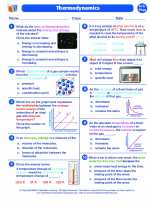Thermodynamics -> environmental engineering
Environmental Engineering
Environmental engineering is a specialized field of engineering that focuses on protecting the environment and public health. Environmental engineers develop solutions to environmental problems using principles of engineering, biology, chemistry, and soil science. They work to improve air and water quality, manage waste, and remediate contaminated sites.
Key Concepts in Environmental Engineering
- Air Quality: Understanding the sources of air pollution and developing methods to control and reduce emissions.
- Water Resources: Managing water quality, wastewater treatment, and developing sustainable water supply systems.
- Waste Management: Designing systems for proper disposal and recycling of solid and hazardous waste.
- Environmental Impact Assessment: Evaluating the potential environmental effects of proposed projects and developments.
- Remediation of Contaminated Sites: Developing strategies to clean up and restore polluted environments.
- Sustainable Development: Incorporating environmental considerations into the design and implementation of engineering projects.
Study Guide for Environmental Engineering
To excel in the field of environmental engineering, students should focus on mastering the following topics:
- Environmental Chemistry: Understand the chemical processes involved in environmental pollution and remediation.
- Air Pollution Control: Learn about methods to reduce emissions from industrial processes, vehicles, and other sources.
- Water Treatment: Study the principles and technologies used for treating and purifying water for human consumption and environmental protection.
- Soil Remediation: Understand techniques for cleaning up contaminated soil and restoring its quality.
- Environmental Laws and Regulations: Familiarize yourself with the legal framework governing environmental protection and compliance.
- Sustainability and Resource Management: Explore strategies for sustainable use of natural resources and minimizing environmental impact.
Additionally, students should gain hands-on experience through internships, research projects, and practical applications of environmental engineering principles in real-world scenarios. Developing strong problem-solving and critical thinking skills is essential for addressing complex environmental challenges.
By mastering these key concepts and gaining practical experience, aspiring environmental engineers can contribute to creating a more sustainable and environmentally friendly world.
.◂Physics Worksheets and Study Guides High School. Thermodynamics

 Worksheet/Answer key
Worksheet/Answer key
 Worksheet/Answer key
Worksheet/Answer key
 Worksheet/Answer key
Worksheet/Answer key
